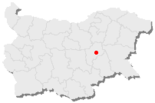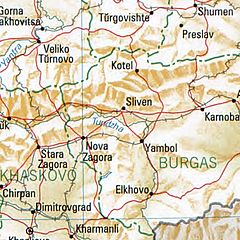Sliven
| Sliven (Сливен) | |||
|
|||
| Basic data | |||
|---|---|---|---|
| State : |
|
||
| Oblast : | Sliven | ||
| Residents : | 87,322 (December 31, 2016) | ||
| Coordinates : | 42 ° 41 ′ N , 26 ° 19 ′ E | ||
| Height : | 243 m | ||
| Postal code : | 8800 | ||
| Telephone code : | (+359) 044 | ||
| License plate : | CH | ||
| administration | |||
| Mayor : | Stefan Radev | ||
| Ruling party : | GERB | ||
| Website : | www.sliven.bg | ||
Sliven [ slivɛn ] (also Sliven written Bulgarian Сливен ) is a city in Bulgaria with 87,322 inhabitants (Census 2016) of the foothills of southeastern arm Balkan Mountains area. The city is the administrative center of a municipality of the same name and the province of Sliven . Sliven is the third largest textile center in the country after Sofia and Gabrovo ; Industrial and garrison town as well as the cultural center of the area.
Geography and location
North of Sliven are the southeastern foothills of the Balkan Mountains , which end here with the huge wall of the Sinite kamâni (blue stones) made of quartz porphyry , a hallmark of the city. This area with the Balgarka mountain peak was declared the Sinite Kamani Nature Park in 1980 , which today covers an area of 11,380 km².
The Sliven Plain (also Slivensko pole ) extends south of the city . The basin character is weak and is traversed by the tundscha and in its eastern part by the Motschuriza. To the north is the city especially from Grebenez and Terzijski bair, massifs of the Balkan Mountains, and south of the eastern foothills of the Sredna Gora and the hills of the Bakadschizi limited.
Places in the vicinity are: Yambol , Nowa Sagora , Stara Sagora , Elchowo , Tschirpan , Dimitrovgrad , Charmanli , Kotel , Veliko Tarnowo , Targovishte , Preslav , Shumen .
history
The city was first mentioned in the middle of the 12th century by the Arab traveler al-Idrisi under the name Istilīfunūs, but the ruins around it show that this area was already settled during the time of the Roman Empire .
Evliya Çelebi described the city under the name Islimiye in his travel book Seyahatnâme in the 17th century . Under this name it was the capital of a sanjak in the Ottoman Empire .
Sliven was a center of handicrafts and trade and the Bulgarian revival in the late 18th and 19th centuries . The country's first textile factory was founded here in 1834. It was called "the city of 100 voivods " because many freedom fighters and military leaders came from here, such as the voivodes Chadschi Dimitar (1837–1868) and Panayot Chitow (1830–1918) as well as the fighter for national education Sawa Dobroplodni (1820–1894 ) and Dobri Tschintulow (1823–1886).
In 1860 the Tschitalischte "Sora" was founded, which gave the impetus for the creation of a theater. The old houses with wood carvings and the memorial museums are worth seeing.
Sliven is known in Bulgaria as the "City of the Winds and Gypsies". Due to the geographical location, northern winds from several Balkan passes meet here. “ Gypsies ” is a reference to the high proportion of Roma in the city's population.
The city has given its name to Sliven Peak , a mountain on Livingston Island in Antarctica , since 2002 .
population
Sliven at the end of 1994 had 107,267 inhabitants and today only 86,275. Compared to other Bulgarian cities, the city has a particularly large proportion of around 20,000 inhabitants of Roma who live in the Nadhezda ghetto.
- Population development
The changing population figures partly result from the respective territorial status.
|
|
|
The figures come from censuses (¹) or official updates from the statistical offices (²).
Economy and Infrastructure
The main sectors are agriculture and mechanical engineering as well as the food industry. Larger companies are the Domaine Boyar and Vini AD wineries ; the textile companies Mirolio and Dokotex Karpet AD , and the Tirbul dairy .
Sports
The OFC Sliven 2000 plays in the season 2012/13 in the Second Bulgarian league. He plays his games in the Khadji Dimitar Stadium .
Sliven is one of the venues for the 2015 U-17 European Football Championship in Bulgaria .
Town twinning
Sliwen’s twin cities are
|
sons and daughters of the town
- Anton Pann (1794 / 1798–1854), poet, composer and musicologist
- Iwan Seliminski (1799–1867), doctor and scholar
- Chadschi Dimitar (1840–1868), Bulgarian freedom fighter and revolutionary
- Julia Kristeva (* 1941), feminist psychoanalyst and philosopher
- Ivan Michailow (* 1944), boxer
- Norair Nurikjan (* 1948), Olympic champion in weightlifting
- Rossiza Pechliwanowa (* 1955), middle-distance runner
- Jordan Letschkow (* 1967), former national soccer player and mayor
- Tontscho Tontschew (* 1972), boxer
- Bogdan Rusev (* 1975), writer
- Dimitar Shtiljanow (* 1976), boxer
- Milena Nikolova (* 1984), writer
- Desislava Bozhilova (* 1992), snooker referee
literature
- Peter Soustal: Thrace (Thrace, Rhodope and Haimimontos). (= Tabula Imperii Byzantini Volume 6) Verlag der Österreichischen Akademie der Wissenschaften, Vienna 1991, ISBN 3-7001-1898-8 , pp. 462–464 sv Stilbnos.
Individual evidence
- ↑ a b Population of Sliven by year , National Statistics Office, accessed August 3, 2014
- ^ Website Sliwen - Mayor , accessed April 22, 2017
- ↑ Peter Soustal: Thrace (Thrace, Rhodope and Haimimontos). Tabula Imperii Byzantini Volume 6, Verlag der Österreichischen Akademie der Wissenschaften, Vienna 1991, ISBN 3-7001-1898-8 , pp. 53–55.
- ↑ Boris Nedkow: Bulgarija i susednite i zemi prez XII vek spored "Geografijata" na Idrisi. La Bulgarie et les terres avoisinantes au XIIe siecle selon la "Geographie" d'al-Idrissi. Nauka i izkustwo, Sofia 1960, pp. 86–87, 104–105, 144.
- ^ Hans-Joachim Kißling : Contributions to the knowledge of Thrace in the 17th century. Steiner, Wiesbaden 1956, pp. 46-47.
- ↑ Andreas Birken : The provinces of the Ottoman Empire. In: Supplements to the Tübingen Atlas of the Middle East , Series B No. 13, Wiesbaden 1976, p. 99.
- ↑ NZZ am Sonntag: Gypsy life is sad ( Memento from January 2, 2017 in the Internet Archive )
- ↑ Population figures as of June 15, 2012 (Bulgarian) at the registration office
- ^ Website Sliwen - Partner Cities , accessed on April 22, 2017



